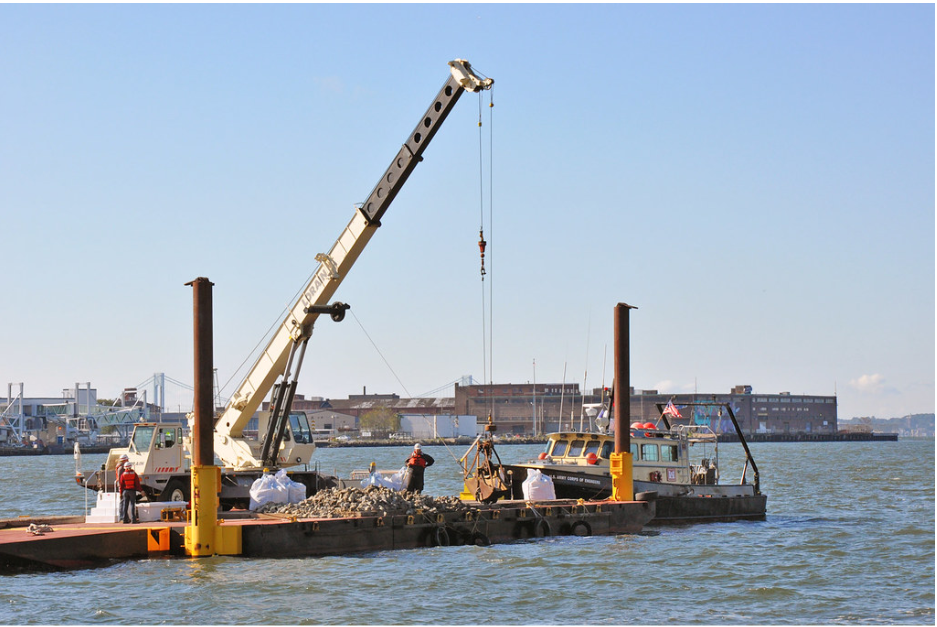Like most Australians, you probably haven’t given much thought to oyster reefs, except when you’re ordering a yummy entree for your night out, or watching out for their sharp shells on your beach trip. But for many of the coastal towns of NSW, oysters are an important source of income and heritage. The sheltered waters of the NSW coast are home to over 250 oyster farms.
Together they make up the largest aquaculture industry in NSW. While the industry produced over 3.5 tonnes of oysters in 2018, these numbers are nothing compared to the number of oysters that used to thrive in natural reefs up and down the coast of Australia.
In the old days…
Today’s oyster industry relies on the careful cultivation of oysters on man-made structures, while wild oysters are confined to hard surfaces in sheltered shores and estuaries. Looking at the coastline today, you might think things have always been this way, but history paints a different picture.
When European colonizers first arrived in Australia, they found vast reefs of oysters and mussels all along the coast. Some reef patches were over 100 000 metres squared . That’s bigger than 14 football fields! Stories from early colonial history describe reefs so rich with oysters that a fisherman could sit in one spot for days and not run out of oysters to collect. Aboriginal middens all along the coast are full to the brim with thousands of years of oyster shells.
Fast forward to today, and oyster reefs are one of the most endangered marine ecosystems in Australia. There are no subtidal oyster reefs left, and only six intertidal reefs that we know of. The maths adds up to a loss of over 90% of historical reefs. So what happened to them?
Disappearing oysters reefs

It’s not exactly clear what caused the oyster reefs to disappear. One popular theory is overharvesting. For early European colonists arriving in Australia, oysters were an easily accessible source of good food in an unfamiliar landscape. Oyster shells were also a valuable source of lime, a key ingredient in mortar used for construction. Oysters were heavily dredged, often resulting in the striping of entire reefs back to bare sediment. At the same time, water quality dropped due to development along the rivers and estuaries, and mudworms began to appear in outbreaks, killing many oysters.
By the end of the 19th century so few oysters were left that wild harvesting had largely stopped. People instead turned to aquaculture. Regardless of what killed the reefs, they haven’t recovered since they first started disappearing 100 years ago.
Why does it matter that oyster reefs haven’t recovered?
We can’t know exactly what was lost when the reefs disappeared, but we can guess. Oysters in aquaculture farms are capable of filtering over 250, 000L of water in their lifetime, meaning that oyster reefs would have played an enormous role in keeping our coastal waters clean. Much like coral reefs, the hard, complex surface of oyster reefs would have provided all kinds of hidey holes and small habitats for fish, supporting whole ecosystems that now barely exist. Reefs, whether they’re made of coral or oysters, also help protect beaches from eroding in big storm events by absorbing energy from waves before they arrive on shore.
The loss of these reefs didn’t just impact the environment either. It was also a loss of an important source of food and culture for Indigenous communities (Read more here).
Restoring the oyster reefs
Australia isn’t the only place to see a startling loss of shellfish reefs. It’s happening all over the world. The good news is that recent attempts to begin to restore shellfish reefs have seen promising results, with multiple recovery projects underway in Australia and the USA. Dredging is one of the reasons shellfish reefs have struggled to recover in the past. By removing the oysters, dredging also removes the hard surface of the reef and replaces it with sandy sediment. Baby oysters (called “spat”) only settle on hard surfaces, like old oyster shells. Without the old oyster beds there was nowhere for new reefs to grow.
Restoration projects aim to encourage the return of wild oysters by putting hard surfaces back in places where shellfish reefs used to be. Even old oyster shells from restaurants are being recycled and put back out into estuaries for new oysters to grow on as part of a recycling project called Shuck Don’t Chuck. Not only is this helping the oyster reefs, it’s also keeping the shells out of landfill!

How can drones help?
Drones are being used to help monitor restoration success and keep track of surviving reefs. Traditionally, monitoring restoration projects can be really data hungry, and oyster reefs can be tricky or expensive to monitor regularly through field work. Drones offer a quick easy way to survey large areas to see how reefs are doing. Scientists are even working on teaching computers to automatically recognise oyster reefs from drone images so it’s easier for us to learn more about these awesome ecosystems.
While there is still a lot of work to do, hopefully we’ll begin to see the return of these amazing ecosystems to our shorelines soon.
Check out the links below if you want to learn more about oyster reef restoration around Australia:
Reef Builder: Rebuilding Australia’s lost shellfish reefs
Huge restored reef aims to bring South Australia’s oysters back from the brink
Largest community-driven shellfish reef restoration in Australia gets started
Find this dataset on GeoNadir
This blog was inspired by a dataset uploaded by Mick B. You can click here to explore this great dataset on the GeoNadir platform.
Oyster reef restoration isn’t the only space where drones are helping scientists better understand the natural environment. From forests, to deserts, to the coast, check out some of the amazing datasets scientists have uploaded on GeoNadir.





